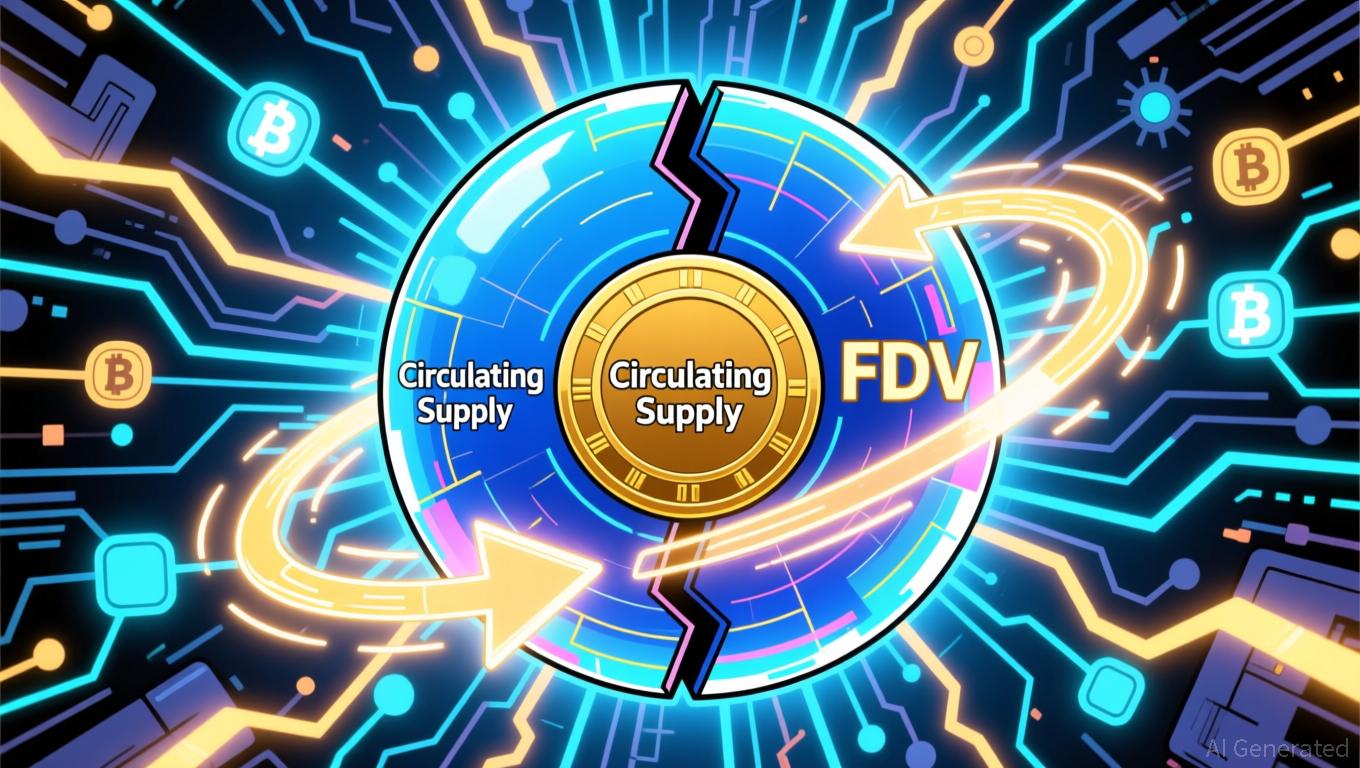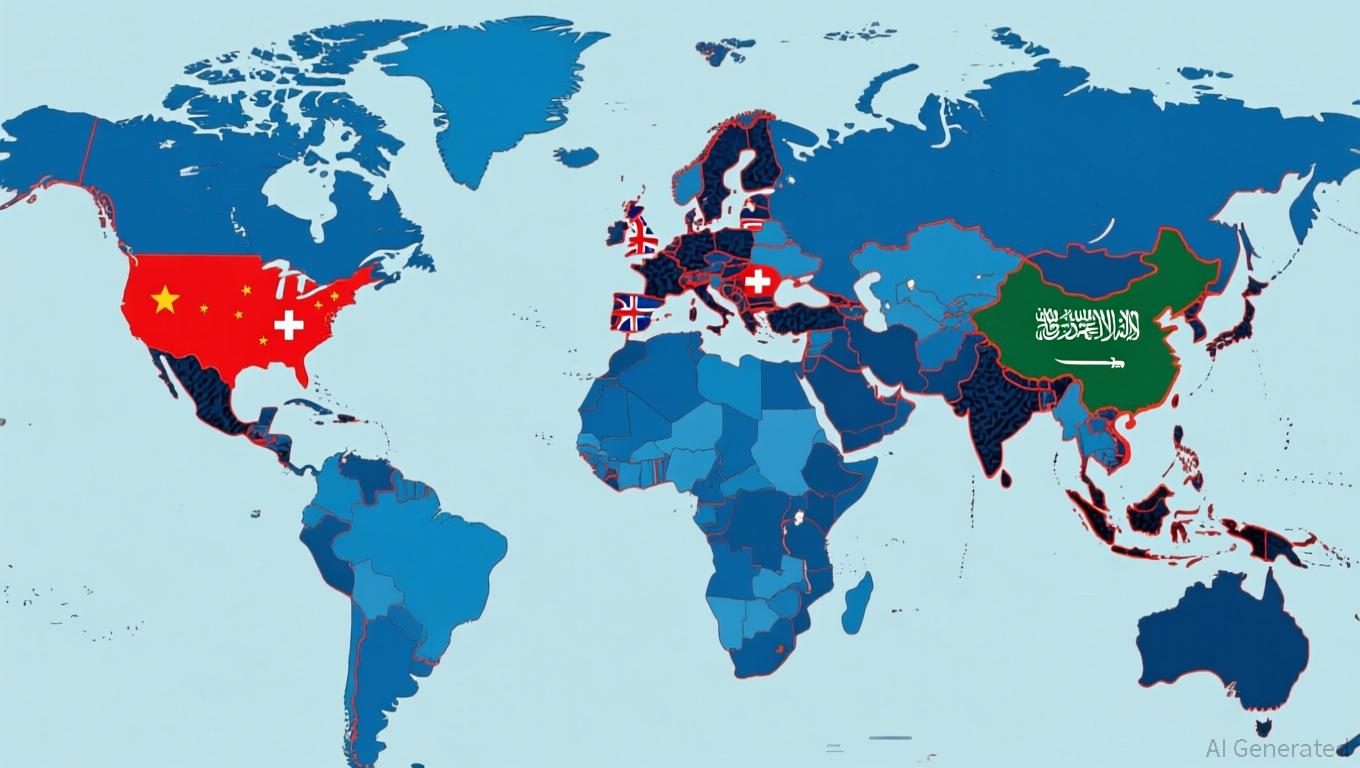FDV's Dilemma: Assessing Opportunity While Concealing Risk
- FDV (Fully Diluted Valuation) has become a 2025 key metric for evaluating crypto projects' long-term risks and scalability, especially for new layer-1 blockchains like Monad and Apertum. - Monad's $3.9B FDV despite 12% unlocked supply highlights "low float, high FDV" dynamics, while Apertum's 1.05x FDV-to-market cap ratio signals minimal dilution risk. - Critics note FDV's limitations, including price volatility assumptions and irrelevance for uncapped supply projects like Ethereum , requiring contextual
Understanding FDV in the 2025 Crypto Landscape
In 2025, Fully Diluted Valuation (FDV) has become an essential benchmark for evaluating the long-term prospects and potential pitfalls of cryptocurrency projects. This is especially true as innovative layer-1 blockchains such as Monad and Apertum enter the market with bold token distribution strategies. FDV calculates what a cryptocurrency’s market cap would be if every token—both those already in circulation and those still locked—were available at the current price. This figure helps investors assess the risk of dilution and the scalability of a project, while also exposing weaknesses in tokenomics structures.
Case Study: Monad’s Mainnet Launch
The recent rollout of Monad’s mainnet highlights the importance of FDV. When Monad’s MON token was introduced on November 24, 2025, it launched with an FDV of $3.9 billion, even though only about 10–12% of its total 100 billion tokens were accessible. The token’s price initially dropped to $0.025 (reducing FDV to $2.5 billion) before recovering to $0.039. This rebound was supported by a 3.3% airdrop and a $269 million public sale, which helped establish a committed base of holders and mitigated early selling pressure. This stands in contrast to many other tokens released in 2025, where airdrops often led to rapid price declines due to speculative selling.

FDV: Revealing Hidden Risks
FDV is particularly useful for uncovering underlying risks. In Monad’s case, the combination of a high FDV and a small circulating supply (3.3% from the airdrop and 7.5% from the public sale) creates a scenario where only 12% of tokens are tradable, while over half (50.6%) remain locked until 2029. This setup encourages early investors to hold, but it also means that future token unlocks could lead to increased selling pressure.
Similarly, Apertum (APTM), a layer-1 blockchain built on Avalanche, presents a different picture. With an FDV of $312 million and a market cap of $298 million, and with 98% of its 2.1 billion tokens already in circulation, the dilution risk is minimal. The FDV-to-market cap ratio of 1.05x reflects this stability.
Limitations of FDV
Despite its usefulness, FDV has its shortcomings. It assumes that token prices will remain unchanged as new tokens are released, which is rarely the case. For example, well-known trader Arthur Hayes has pointed out that MON’s price surge is driven more by speculation than by underlying value, noting that the combination of a low circulating supply and high FDV can be both advantageous and risky. Furthermore, FDV loses relevance for tokens with unlimited supply, such as Ethereum, where ongoing inflation complicates valuation.
Interpreting the FDV-to-Market Cap Ratio
Another important consideration is the ratio of FDV to market capitalization. A ratio below 0.5 suggests significant future dilution, while a ratio above 0.8 indicates relative stability. Monad’s current ratio of about 0.8 (with a $3 billion market cap versus a $3.9 billion FDV) points to moderate risk. In contrast, some altcoins in 2025 have ratios exceeding 10x, making them vulnerable to sharp price drops as locked tokens become available.
The Road Ahead for FDV
The effectiveness of FDV as a metric will depend on how projects handle token distribution. Monad, for instance, has allocated $1.15 billion (38.5% of its total supply) to ecosystem development, aiming to attract both developers and users, which could help justify its high FDV. On the other hand, Apertum’s deflationary approach—burning transaction fees to reduce supply—could help maintain long-term value in line with its FDV.
Conclusion: FDV as a Guiding Signal
As the cryptocurrency sector evolves, FDV will continue to be a vital tool for project evaluation. However, it should be used alongside other on-chain indicators such as Total Value Locked (TVL) and transaction activity. For Monad, the coming year and a half will reveal whether its early momentum can translate into lasting growth and developer engagement. Ultimately, FDV serves as a cautionary indicator for investors, highlighting potential risks rather than providing absolute predictions.
Disclaimer: The content of this article solely reflects the author's opinion and does not represent the platform in any capacity. This article is not intended to serve as a reference for making investment decisions.
You may also like
Monero’s reputation for privacy faces challenges from modular competitors and evolving regulations
- Monero (XMR) nears $400 as privacy-focused crypto gains traction amid evolving market demands for modular solutions. - Emerging rivals like Solana's GhostwareOS and Zcash challenge Monero's dominance with interoperable privacy features. - Regulatory pressures, including South Korea's expanded AML rules, heighten scrutiny on privacy coins despite their anti-surveillance design. - Analysts highlight Monero's "extreme privacy" legacy but note growing adoption of integrated privacy tools in active blockchain

As Crypto Markets Fluctuate, BI DeFi's Eco-Friendly Cloud Approach Draws Growing Attention from Institutions
- BI DeFi launches a blockchain-powered cloud computing platform combining renewable energy and advanced security to stabilize crypto market risks. - XRP's $180M inflow highlights growing institutional interest in digital assets despite broader market volatility and billions in sector outflows. - The platform's green energy data centers and automated yield settlements address ESG priorities while reducing blockchain's carbon footprint. - User-friendly features like $17 introductory contracts and $50K affil

Switzerland Delays Crypto Information Exchange Pending International Coordination
- Switzerland delays crypto tax data sharing with foreign nations until 2027, citing unresolved CARF partner agreements. - The OECD's 2022 framework requires member states to exchange crypto account details, but 75 countries including the EU and UK face implementation challenges. - Transitional measures ease compliance burdens for Swiss crypto firms while awaiting finalized international data-sharing protocols. - Major economies like the U.S., China, and Saudi Arabia remain outside CARF due to non-complian

Bitcoin Updates: SGX Addresses Offshore Perp Shortfall as Bitcoin Decline Increases Demand for Hedging
- SGX launched Bitcoin and Ethereum perpetual futures, becoming a first-mover in regulated onshore crypto derivatives to meet institutional demand. - The $187B/year perp market, dominated by Asia, now gains a regulated alternative to offshore platforms with SGX's 22.5-hour trading window. - Perps enable hedging during Bitcoin's 2025 downturn, with SGX's margin-call system prioritizing investor protection over instant liquidations. - Regulatory caution limits access to accredited investors, aligning with gl
